Safety Guide for Photon Factory Users
Photon Factory (PF), Institute of Materials Structure Science (IMSS), High Energy Accelerator Research Organization (KEK)
April, 2025
1. Introduction
The Photon Factory (PF) is a Japanese national synchrotron radiation research facility affiliated with the Institute of Materials Structure Science (IMSS) of the High Energy Accelerator Research Organization (KEK). It is supervised by the Ministry of Education, Culture, Sports, Science and Technology (MEXT; Monbu-Kagaku-Sho). At the Photon Factory, various experiments are carried out using synchrotron radiation X-rays and vacuum-ultraviolet light generated by the PF and PF-AR storage rings. In this guide, the precautions to be taken for the safe use of the facility are outlined. The most important rule for safety is:
"Each experimenter is responsible for his or her own safety."
In addition to the first rule, because many experimentalists are working together and doing various experimenters in a common space, another special caution is necessary in the experimental halls.
"Always consider the safety of the others."
Please read this document carefully before starting your experiments. Important notices are summarized here to protect the safety and health of PF users and staff.
Please refer also to the pamphlets concerning the regulations of KEK, which are provided at each experimental station. Most of these are in Japanese only, but an English phamphlet "Safety Guidebook" is also available online as a PDF file.
Beamline Display Board
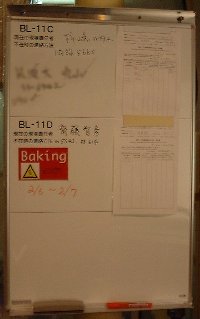 |
2. Administrative System for Safety
The following members of PF staff are assigned to deal with aspects of safety such as radiation safety, electrical safety, and fire prevention -- please see the table below.
List of PF Safety Staff
| Responsibility | Name of person(s) in charge |
|---|
| Supervisor | H. Oshita, Y. Kitajima |
| Radiation Safety | H. Nitani |
| Beamline Interlock System | H. Ishii, H. Nitani, T. Kosuge |
| Fire & Disaster Prevention | A. Matsuoka, S. Nozawa, A. Koyama |
| Electrical Safety | A. Toyoshima |
| Chemical Safety | Y. Kitajima, H. Oshita |
| Toxic or Flammable Gases | Y. Niwa, J. Adachi |
| High-Pressure Gas Cylinders | Y. Uchida |
| Cryogen | T. Mori |
| Lasers | S. Nozawa |
| Information Security | N. Matsugaki |
|
| Responsibility | Name of person(s) in charge |
|---|
| Cranes | T. Kikuchi |
| Machine Shop | T. Mori, Y. Shibazaki |
| X-ray Preparation Room | R. Kumai |
| Biology Preparation Room | N. Usami |
| Phisiology Preparation Room | H. Takagi |
| Crystallization Preparation Room and Cold Room | M. Hikita |
| Dark Room | H. Sugiyama |
| Chemistry Laboratory | Y. Niwa |
| Evaporation Laboratory | T. Kikuchi |
| IP Reader | Y. Shibazaki |
|
When the storage rings are in operation, a floor manager (Unten-Toban in Japanese) and his/her assistant are on duty and carry responsibility for the operation of beamlines and safety systems in the experimental halls. They can be contacted at any time since they carry a mobile "handy-phone" (PHS), number 4209. You must follow their instructions regarding safety in all cases.
"Beamline Display Board" (BDB) is placed at each beamline to inform everyone what kind of experiments are in progress at the branch beamlines. Detailed explanation of BDB is in a web page:
https://pfwww.kek.jp/safety/chem/bldisp-e.html.
Every experimental group should post a copy of the pre-submitted "Declaration of introduction of samples/chemicals into the Photon Factory" form on the BDB. The accepted form can be found at the main entrance of the experimental hall. Other safety notices such as "On Baking", "Laser Beam Operation" etc. should also be displayed when appropriate. Contact information of a member who is currently responsible in your experiments should be input to the "PF Experiment Information Management System" [accessible only in KEK].
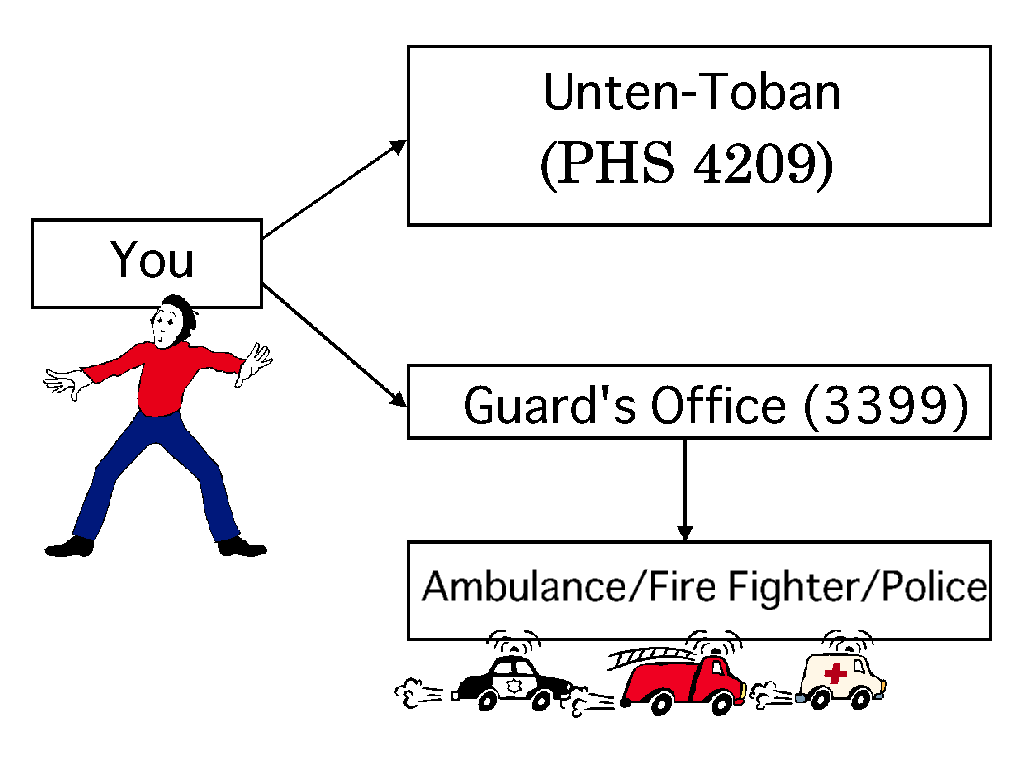
3. In case of Emergencies
Your first priority should be to secure your own safety. Before starting your experiments, please note the locations of emergency exits, fire extinguishers and fire alarms. In order to keep the evacuation route accessible, do not leave anything outside of the yellow line and the passageways between beamlines. Never pile up things or lean ladders near the passages since they might fall down during an earthquake. Don't put heavy items in high places.
SOS buttons are installed on the ground floor of the PF Research Building and the PF-AR area. When one of these buttons is pushed, an emergency announcement will be made in the corresponding area.
SOS Button
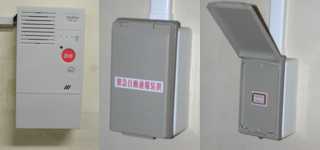 |
|
Emergency Assembly Areas
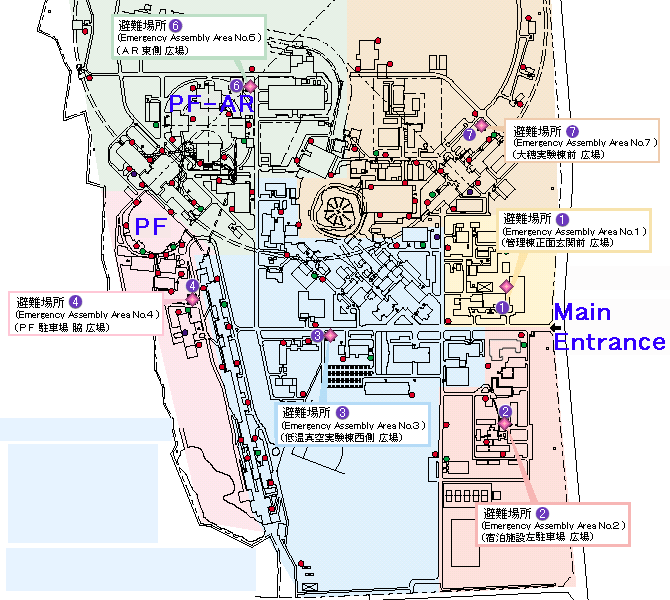 |
|
Emergency Exits in the PF Experimental Hall
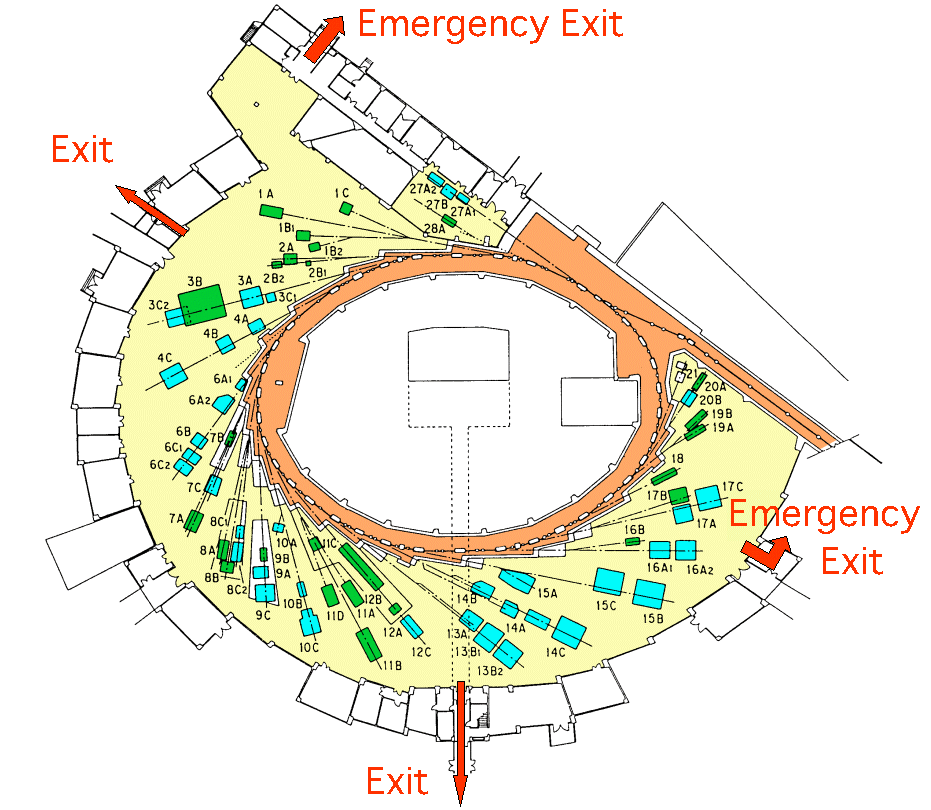 |
|
3-1 In case of a fire
If you notice a fire, shout "Fire!" and raise the alarm. Dial 3399 for the guard and also 4209 for the Unten-Toban. It is sometimes dangerous for one person to fight the fire, and the best method for dealing with the fire depends on the cause. Follow the instructions of the Unten-Toban and PF staff.
3-2 In case of an injury
A first-aid kit for minor injuries is available at the Unten-Toban's office. If an ambulance is necessary, dial 3399 to inform the Guard's office. Also call the Unten-Toban on 4209.
3-3 Emergency Assembly Areas
In case of a fire or earthquake, everyone should escape from the building and gather in the assigned "Emergency Assembly Areas". They are mostly near parking areas, and are shown in the figure. Please report your group members' situation to the staff there.
4. Radiation Safety
The Radiation Science Center of KEK provides personal dosimeters and a personal ID card. These are obtained from an attendant at the entrance to the PF experimental hall. The ID card is required to enter and leave radiation-controlled areas, including the experimental hall. The dosimeters and the ID card should be returned before leaving KEK, or upon the request of the attendant. Personal dosimeters are usually replaced and checked every month. The Radiation Science Center regularly surveys the radiation level in the experimental halls.
Personal Dosimeter &
ID card

|
- Be careful not to be exposed unnecessarily to the radiation during experiments using synchrotron radiation, X-rays from generators, radioisotopes, checking-sources, etc. The PF and PF-AR storage rings are inside shielding walls and hence the radiation levels in the experimental halls are usually kept below 20 microSv/h. If you follow the KEK regulations, you need not worry about any excess radiation exposure. If you have any questions, please contact the Unten-Toban before starting your experiments.
- Physiological disorders caused by radiation exposure may not appear quickly. If there is any possibility of excess exposure to radiation, report immediately to the attendant. Delayed discovery of dosimeters that have received an excessive amount of radiation exposure hampers the investigation of the cause. Also if you lose your dosimeter or accidentally leave it in an X-ray hutch, even for a short while, you have to inform the attendant. Dosimeters will be replaced.
- If you need to use radioisotopes or nuclear fuels such as U and Th, even in a small amount, please contact the persons in charge of radiation safety.
- Eating and drinking are prohibited in the experimental halls.
5. Beamline Interlock System
Station Controller
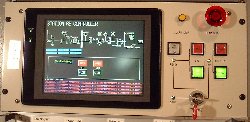
|
|
|
Key Operation for X-ray Hutch
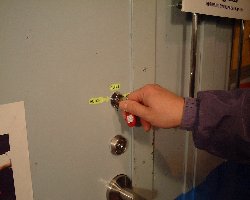
|
|
In order to protect experimenters from radiation hazards, and to preserve the vacuum in beam-transport lines and the beamline components, there is a "Beamline Interlock System". Experimenters can only handle the "Station Controller" located at the experimental station, and the key for the experimental hutch on the X-ray beamlines.
- To open the Main Beam Shutter (MBS) after the electron-beam injection is complete, you have to turn the MAIN key (OPC key in the new system) on the Station Controller to the ENABLE position, and then press the MBS-OPEN-REQ button.
- On the VUV-SX Beamlines, open all the valves and the Branch Beam Shutter (BBS) to let the beam through to the experimental station.
- On the X-ray Beamlines, all the valves are usually open. In order to introduce the X-ray beam, the experimental hutch must be closed with the proper procedure. The BBS can then be opened by turning the AUX key on the Station Controller to the EXP position. On beamlines with a downstream shutter, the SHUTTER also needs to be opened. In order to enter the hutch, close the BBS, check that the BBS-CLOSE light is on, and then use the key from the station controller to open the hutch. On beamlines equipped with a downstream shutter, the hutch can be opened just by closing this shutter.
- In case of an emergency where the X-rays must not enter the experimental hutch, you can abort the stored electron beam with pulling one of the "DUMP" button on the Station Controller or in the hutch.
- The Beamline Interlock System regularly monitors the operation of valves and shutters, the open/closed status of hutches, the vacuum in the beamlines, coolant flow and temperature, and the pressure of compressed air. If a trouble occurs or some status becomes unusual, a "DISTURB" alarm sounds. If this happens, please contact the Unten-Toban.
6. Safety Guide for Chemicals and Toxic and/or Flammable Gases
- Every user group must submit a "Declaration of introduction of samples/chemicals into the Photon Factory" form two weeks before the first day of the beam time. Please declare any substance which you will bring, regardless of amount or form.
- Prevention of loss and theft of samples and chemicals brought into the Photon Factory is your responsibility. Please contact the Unten-Toban if you require temporary storage for hazardous substances. Chemicals may only be stored at KEK during your stay, and must be removed from the campus when your stay is over.
ID Card Controlled Storage of Hazardous Chemicals
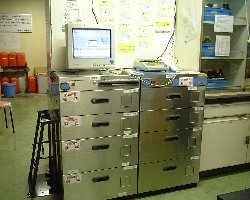
|
- Experiments creating liquid waste should be carried out in the chemistry laboratory, physiology laboratory or biological sample preparation rooms. The last ones can be found in the RI area.
- Hazardous chemicals such as acids or alkalis are stored in ID-card controlled cabinets in the chemistry laboratory. Please ask the Unten-Toban if you wish to use them.
- When you use the chemistry laboratory, please note the location of the shower and eye-washing facility before starting work.
- The amount of solvents such as alcohol and acetone brought into the experimental halls should be minimized, since they can be a fire hazard.
- The "Guide for Chemical Safety for PF Users" is available as a web page at
https://pfwww.kek.jp/safety/chem/chemsafe-e.html.
- Toxic and/or flammable gases are categorized as "Special Gases" at the Photon Factory. Whenever you use a "Special Gas", you should submit a "Registration form for special gases" in addition to the "Declaration of introduction of samples/chemicals into the Photon Factory" form and describe the safety measures needed to handle the gas. Your gas handling system should be inspected by the PF staff in charge before the usage of special gases.
7. Electrical Safety
The most serious accidents caused by electricity are electric shocks and fires caused by overheating. The followings are safety measures to avoid electrical accidents.
Leak-Current Detector
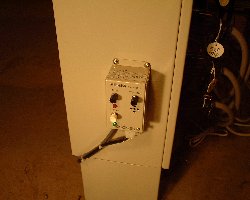
|
- Usually, users can use the electric power box at each experimental station only with the permission of the station master. Check the supplied voltage and the capacity before wiring. Overloaded circuits may cause a circuit breaker to trip, and result in damage to connected equipment. Use sufficiently thick cables to avoid overheating. For example, the capacity of a cable of 2 mm2 is 23 A, so that you should use a 3.5 mm2-thick cable for the 30-A circuit breaker.
- If the alarm of a leak-current detector is triggered, investigate the cause immediately and take proper measures to prevent it happening again. Report the situation to the Unten-Toban.
- Performing wiring work without switching off the electricity is extremely dangerous. Double-check that the supply is turned off before beginning the work.
- If you feel any electric shock, investigate its cause immediately. Avoid grounding as a method of preventing leakage currents, since this can be a source of electrical noise.
- Do not use excessive branching and wound cord reels. They might cause overheating, and damage to or burning of cables.
- Before starting a bake-out, check the cables and heaters carefully to ensure that the insulation and sheath are not broken or damaged. Confirm there is no leakage current with a clamp-on current meter and inform the Unten-Toban at the beginning of baking. While baking, post a notice sheet on the Beamline Display Board and check safety frequently.
Fixed Gas Cylinders
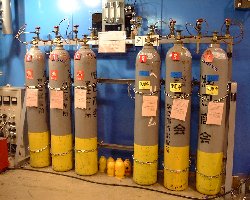
|
8. Safety Guide for using High-Pressure Gas Cylinders
- When you need to use gas cylinders of N2 or He, please contact the beamline staff. Use the proper carriage to transport 7m3 cylinders.
- When gas cylinders are in use, they should be attached to the proper stands. The carriages are designed for transport only -- remember that earthquakes occur frequently in Japan.
9. Traffic Safety in the KEK Grounds
Speed Limit 30km/h
Park Cars in Assigned Areas

|
- The Japanese laws and regulations detailed in the Road Traffic Act also apply within KEK. The speed limit is 30km/h.
- Although pedestrians always have the right of way, please keep to the footpaths when walking within KEK.
- To bring a car into KEK, you need to apply for a "Temporary Automobile Permit".
- While driving within KEK, please remember that pedestrians have the right of way and pay attention also to bicycles.
- Please park cars only in the designated areas.
- If an accident occurs, please dial 3399 for the Guard's Office, who will be able to phone for an ambulance.
- When riding a bicycle after dark, use lights.
10. No Smoking Policy in KEK
Smoking Area
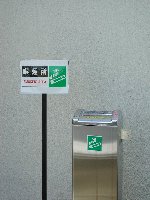
|
Smoking is prohibited throughout KEK, both inside and outside, except for in designated smoking areas. The following areas near the PF and PF-AR are designated for smoking:
- PF : outside of the Experiment Preparation Bldg.
- PF-AR : outside the entrance of the N-Hall
There is a "Smoking Area" sign and an ashtray at each smoking area.
For other smoking areas in KEK, please refer to this map.
11. Miscellaneous Safety Measures
Safety Hats & Shoes
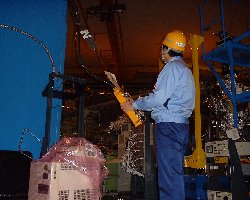
|
- Whenever you are at work, please follow the safety regulations. If you have any further questions, please ask the Unten-Toban or the station master.
- Working alone is not recommended. Any activities with risks should not be carried out unless a second person is standing by.
- You must wear a hard hat and safety shoes whenever carrying/lifting heavy items or working around. These are available in each experimental hall.
- A license and permission from KEK are required to operate cranes or fork lifts. It is strictly prohibited to use them without the licenses.
- The workplace should be always cleaned up after use. Follow the instructions of the Unten-Toban.
- Never leave dewars unattended while filling with liquid nitrogen. An overflow of liquid nitrogen might cause asphyxiation.
- In the workshops the following machine tools and equipment are available: shearing machines, lathes, drilling machines, band saws, milling machines, high-speed sawing machines, grinders, and manual bending machines. They should only be used by well-experienced persons. Please clean up around the machines after use.
- A license and permission from KEK are necessary to operate welding equipment.
- If you need to use lasers, please contact the PF staff in charge, who will onform you of the procedure to start your experiments with lasers.
- When using heating devices, 1)do not place flammable items near the devices, 2)check that there are no electrical short circuits before using the devices, 3)the devices must be equipped with proper safety systems such as fuses and circuit-breakers, and 4)transformers (SLIDACs) must not be used unless equipped with fuses and an ammeter. You are required to submit a completed "Declaration of the intended use of heating devices" form at least two weeks prior to the intended use of any heating device.









